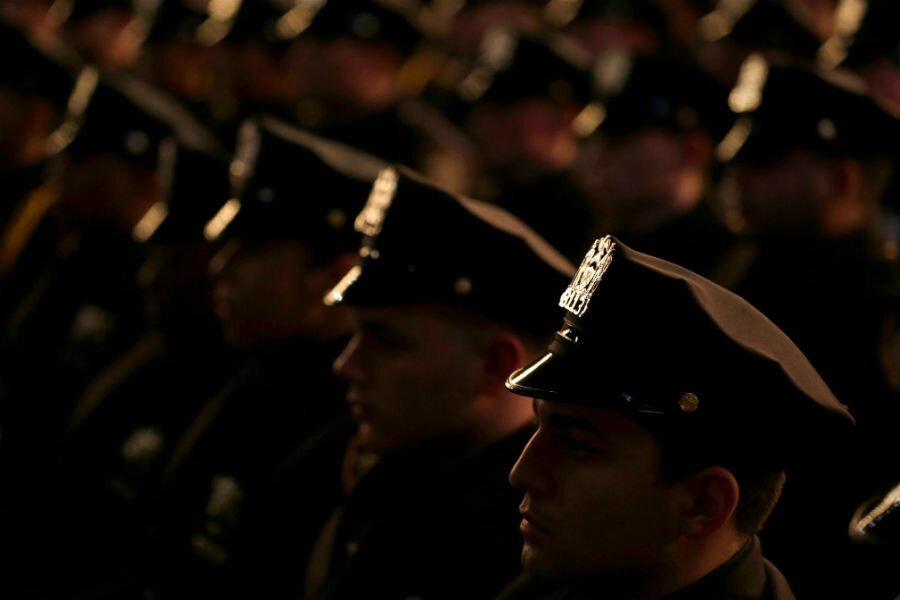Muslim and Sikh NYPD officers can now wear beards and turbans
Loading...
Muslim and Sikh officers in the New York Police Department will be allowed to grow out their beards and wear turbans while in uniform, the NYPD announced on Wednesday.
Under the new policy, outlined by NYPD Commissioner James P. O’Neill, officers who are granted a religious accommodation from the department’s Equal Employment Opportunity Office will be able to grow beards that extend up to half an inch from the face, and may also wear a blue turban with a hat shield in lieu of a traditional police hat. Previously, officers with a medical or religious accommodation were permitted to grow a beard no longer than one millimeter in length, a policy that came under review after a Muslim officer filed a federal class-action lawsuit in June.
"We’re making this change to make sure that we allow everybody in New York City that wants to apply and have the opportunity to work in the greatest police department in the nation, to make sure we give them that opportunity," Commissioner O'Neill said on Wednesday in explanation of the revised rules, as reported by The New York Times.
The decision to allow beards and turbans comes at a time when many US Muslims and Sikhs report feeling unsafe, following a 67 percent increase in hate crimes against Muslims in 2015 and a reported surge in anti-Muslim crimes and rhetoric linked to the 2016 presidential election. There has similarly been an increase in hate crimes and discrimination against Sikhs in the years since Sept. 11, 2001, members of the religious community say, as many Americans have difficulty distinguishing between different types of religious headgear.
"This is happening because the Sikh culture is poorly understood by most people...especially because our fear is making us blind to differences amongst people who look different than we do," psychiatrist Carole Lieberman told The Christian Science Monitor last year. "All strangers feel threatening to us because, as terrorism crosses from foreign countries to America, we are becoming more overwhelmed with fear. People are so angry that the American way of life is being disturbed, that to some, it feels good to commit a hate crime – even if they have mistaken the target of their hate."
While some Muslim women have begun to leave their hijabs at home out of fear of attracting negative public attention, other members of the Sikh and Muslim communities say it's increasingly important for vulnerable religious groups to stand up for their religious identities, as Gloria Goodale reported for the Monitor :
There are signs that the [Sikh] community is beginning to assert its distinct identity and rights. Hapreet Singh Saini, who lost his mother in the mass shooting in Oak Creek, Wis., in 2012 when he was 18, was the first Sikh American to testify in front of Congress after the tragedy. He implored Congress to recognize her religious identity, because “she deserves her rights,” he says.
In addition, while some Sikhs have decided to publicly play down their religious affiliation, earlier this month the US Army issued the first accommodation for a Sikh soldier in a combat position. It will allow Capt. Simratpal Singh to temporarily grow out his beard and wear a turban – actions that have historically been at odds with the military’s strict grooming standards.
Last year, a Sikh accountant won a settlement from the federal government that would allow her to bring her kirpan, a small, sheathed ceremonial dagger to be worn at all times as an article of faith, to work at federal buildings. As a result of her case, the Department of Homeland Security’s Federal Protective Service set up a procedure by which Sikhs could apply for religious accommodations to carry their kirpans into federal buildings. DHS admitted no wrongdoing in the settlement.
In permitting Sikh and Muslim officers to don turbans and grow out their beards, the NYPD joins a small number of police departments with similar policies, including agencies in Washington, D.C., and Riverside, Calif.
There have also been efforts to increase inclusiveness in the US Army. In April, four Sikh soldiers were granted long-term religious accommodations to wear beards and turbans, more than doubling the number of Sikhs who had been previously granted such accommodations.
While supporters applauded the move, they also noted that the current process of applying for religious accommodations is quite laborious and may discourage young religious minorities from serving in the military.
"I think that’s a shame, because that situation basically pushes away young, qualified candidates, be it from the Sikh religion, or from the Muslim religion, or Buddhist," Maj. Kamal Kalsi, the first Sikh to be granted a religious accommodation by the Army in nearly a generation, told the Monitor. "If we want a modern progressive military that looks like America, we’re going to have to come to terms with the fact that not all Americans look alike."
Officer Gurvinder Singh, the president of the Sikh Officers Association, says he hopes the new NYPD policy will encourage more Sikhs to sign up for the police force and lead to greater diversity.
"A lot of their kids wanted to join, but they couldn’t," he told The New York Times. "And now they can. This country has given us a lot, and now we want to pay it back."








